Why do Some People Write in Capital Letters?
The basic rule indicates that the correct way of writing is in lowercase. The goal of capital letters is granting value to a proper name, highlighting a word or phrase to catch the reader´s attention.
Capital Letters in Graphology
Capitals letters are used at the beginning of a line or paragraph, followed by a punctuation mark in the case of proper names. Capital letters are bigger and they generally have a different shape than lowercase letters.
In the language of the IT field, writing in UPPERCASE letters is interpreted as a virtual shout or call to attention. Although this has not been established as a norm or grammar rule, it is adopted by the common sense of users.
Writing in sustained capital letters is considered a sign of discourtesy and to many it is hard to read, since we are used to reading texts in lowercase. To those who suffer visual problems, at present, any internet browser has the basic tools to increase font size.
Psychological Meaning of Capital Letters
From the psychological point of view, capital letters symbolize the ego of the individual. The ego represents the perception of oneself, the level of aspirations, and of self-esteem that, in consequence, will affect the relationship with the environment and what is expected from others. The lowercase letters that are around symbolize the “others”.
Capital letters may be varied. Some are simple, others complicated or elaborated, even resulting strange or hard to understand. Just like the rest of the letters, the shape of capital letters is originated in the calligraphic model learned during childhood, which will be gradually lost (or not) with time and according to the evolution of the writer.
Read also: Handwriting interpretation: Print and cursive
Relationship Between Capital and Lowercase Letters
The relationship between capital and lowercase reveals interesting information about the subconscious of the individual. Graphological analysis studies the relationship between capitals and the rest of the letters. When these are balanced, it represents harmony between what the person thinks of himself and the value granted to others.
When a piece of writing is analyzed in detail, we can detect the perception the individual self-perception and the environment´s, if there is objectivity and if he adjusts to reality, if his aspirations and perceptions are viable or are unmeasured.
The analysis of capital letters in the signature of the individual confirms the level of ambitions and the value the person grants to himself and the value he will grant to others.
The origin of capital and lowercase letters
During antiquity, capital letters were, for a long time, the only type of writing used for inscriptions, official documents and literary works. The invention of lowercase is much more recent. Monks were in charge of writing and copying books at the beginning of the Middle Age in monasteries, using capital letters, a custom inherited from the time when books were written in paper scrolls.
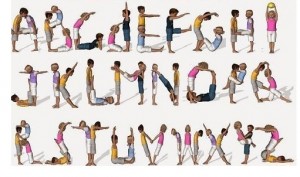
In times of Charlemagne, around the eight century CE, scriveners started using lowercase, cursive and writing their texts with a rounded font.
The invention of lowercase is given to Alcuin of York, teacher of Charlemagne, who in order to facilitate the learning of the Emperor used the Caroline minuscule writing, named after Charlemagne in his honor. Due to its clarity and simplicity, it became the normal writing type for books. The same evolved into gothic writing in Century XII, condensed and ornamental, a thicker type of writing, narrow and angled, that piled up in pages, forming dense bodies of text difficult to read and unpractical.
Can writings in Capital Letters be Analyzed?
Yes, it is possible. When lowercase and capital letters coexist together in a text, the cursive lowercase is analyzed. The use of capital letters (like the use of print) speaks about the writer. We shall analyze the following graphical aspects of capital letters.
What does writing in Capital Letters mean?
Dimension
Capital letters are usually three to four times bigger than lowercase.
- The width in capital letters (the edge of horizontal projection) expresses the spot the individual seeks to occupy in his environment. The social importance he wishes to have and the interests he seeks to wake in others. Vanity feelings.
- The height of capital letters indicates the level of aspirations, expectations, criteria of reality and objectivity with which the individual perceives and judges the reality that surrounds him, whether there is adaptation to that reality, and the feeling he has about himself and his pride. The higher the capital letters, the more self-esteem (dignity, pride and ambition) and what he aspires for himself and his loved ones (in the spiritual sphere, status, professional recognition and power). If the individual loses contact with his concrete reality, he might become a dissatisfied and frustrated person.
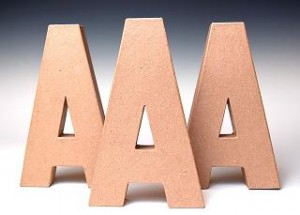
- Big capital letters compared to the rest of the words mean ambition.
- Wide, inflated capital letters mean an “inflated” Ego. It means the individual tends to grant more value to appearances and social status than to people. He feels the desire of being honored, of producing an effect, admiration, of shining. He is vain. He demands being recognized, whishes occupying a large space and standing out.
- Narrow capital letters: Reflexive and cautious attitude. Oppression of emotions and feelings. Lack of freedom to express his thinking or feelings.
- Tall, over-elevated capital letters: Height prevails over the width of letters. They denote conceit, desire of independence, exaltation of the feeling of himself and personal value, pride vanity, superiority feelings, ambition of authority and power, delirium of greatness.
- Short capital letters: In this case the height does not reach the proportion of 3 to 4 times more than the height of the average zone of the writing.
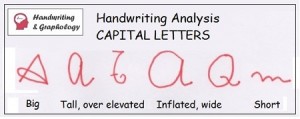
If the graphical environment is positive, with a normal width and harmonic writing, it represents a simple attitude, modest, complacent. The individual does not wish to rule other´s lives. On the other hand, if the letters are narrow and compressed, it reflects shyness, inferiority complex, need for approval and support, lack of self-confidence.
- Unequal capital letters, alternatively tall and short, wide and narrow denote poor self-esteem, insecurity. They indicate the changes the writer suffers and unbalance before outer events.
Shape
The shape may be calligraphic, simplified, simple, complicated, decorated, bizarre or strange. It reflects objectivity and subjectivity in the perceptive point of view of himself and others, honesty or simulation of his intentions, the clarity with which he evaluates and judges.
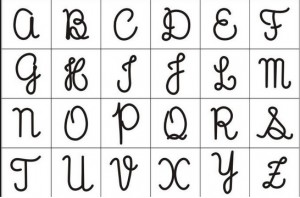
- Calligraphic capital letters: When capital letters are calligraphic, that is to say they are executed the way we are taught during childhood, we infer that the writer grants more importance to his superego than to his personal needs. This person will act according to the norms, customs and incorporated principles from an early age. He is characterized by a conservative way of perceiving and dislikes changes. It denotes a routine person, lacking spontaneity. If accompanied by slow, monotonous and lifeless or automatic writing it is interpreted as lack of imagination and creativity and low intelligence. If it is “short” calligraphic capital writing it means the individual will need the recognition of others, contrary to the case if it is “tall”, where increasing narcissism will be noticed. This person will feel important.
- Typographic capital letters: In this case the capital letters are simplified, like a print letter and the rest of the word in cursive. This reflects taste for esthetics and predominance of intuition. Ability to get to the essence of things. Ability for synthesis. Able to get the essence of things, leaving the secondary aside. If typographic and wide, this acuteness and simplicity will reflect in his relationships, where the individual will have to occupy a fundamental place in the life of those who surround him with balance, harmony and empathy.
- Complicated capital letters: They are overloaded of accessory parts. It signifies exuberance of the ego in search of the outer effect, of feigning, of calling attention, narcissist vanity, snobbism and falseness.
Cohesion
Cohesion is the continuity given to a stroke, if it is interrupted or connected to the following letter. It is analyzed according to the number of existing bonds between letters of a piece of writing. The continuity or connectivity with the rest of the words or their separation denotes the degree of integration, control or spontaneity with which feelings are and aspects of personality are expressed to others.
- If capital letters are connected to the following letter, it represents spontaneity to relate to others, impulsiveness, lack of reflection, fraternity.
- If capital letters are connected to lowercase letters after a bond or centripetal movement, it means that the individual delivers his feelings in a calculating way. There are possessive tendencies, hoarder, jealousy, selfishness, opportunistic individual.
- Disconnected capital letters: In this case they do not connect to the lowercase letters that go together. It symbolizes the need for reflection before acting or surrendering. The individual takes distance.
Handwriting Analysis: Capital letters Slant
- Inclined on words capital letters: They reflect a protective spirit of the writer towards others.
Those who write in print capital letters are people that need to filter their emotions through reason. They do not allow their feelings to come out spontaneously, but they repress them due to distrust, protection or defense. They find it very hard to let their feelings out. They are structured individuals who need to have situations under control, avoiding unforeseen events.
This concludes the article about the Handwriting Analysis of Capital Letters. Feel free to share it with your contacts if you found it useful.

Also Read: Graphology Letter “t”.
Follow us on Facebook. Keep navigating this website to continue discoveringand its usage as a tool for self-awareness and personal development.

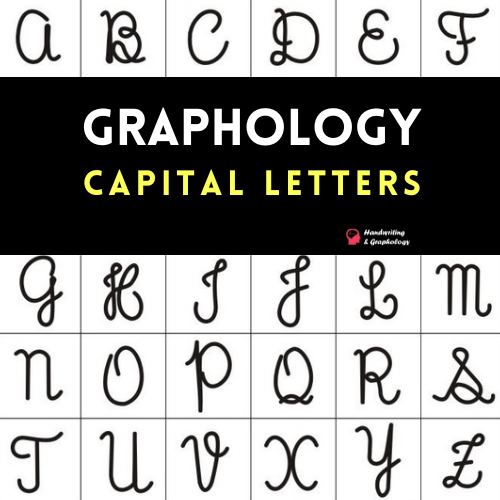
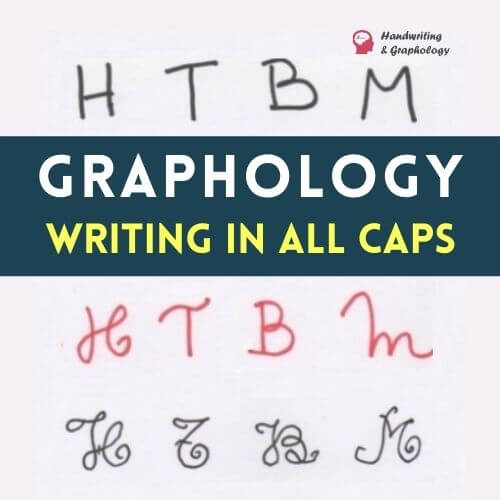
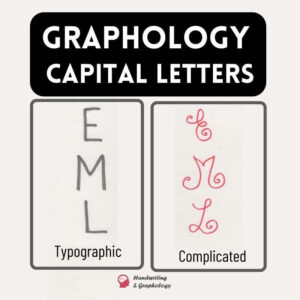
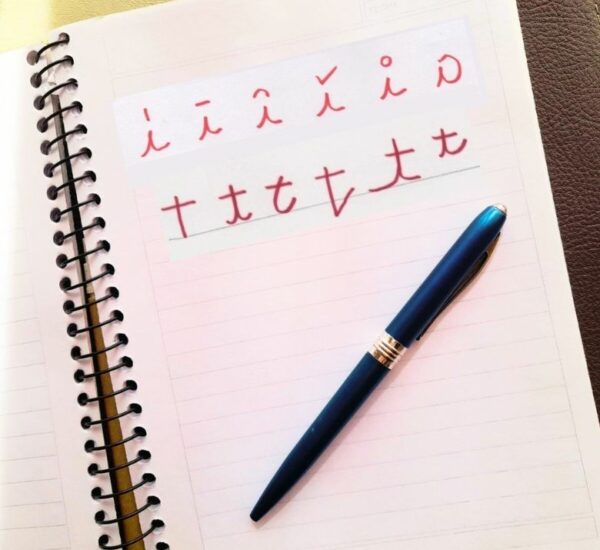
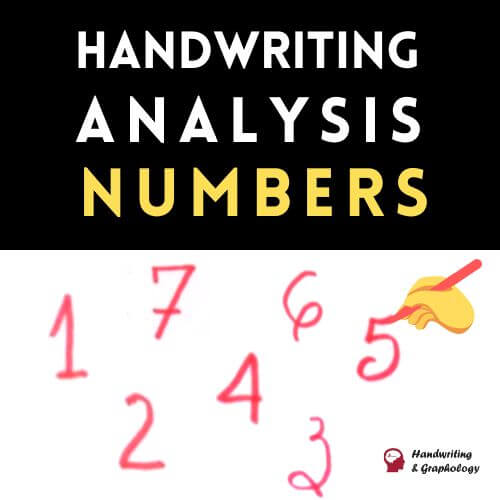
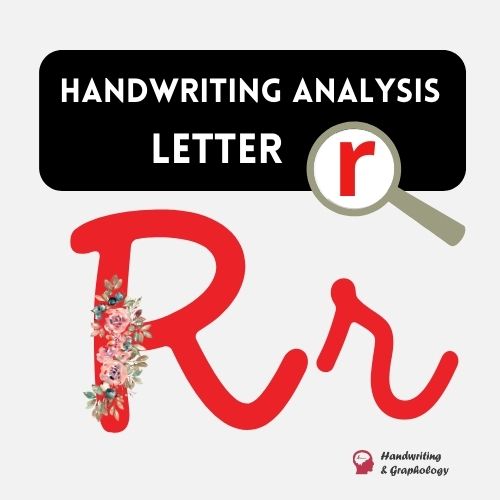
As a police officer I was supposed to write/print my reports in all caps. I did for 25 years. I am now retired and find myself using mix of caps and cursive in the same word.
Like yourself I’ve been in a job for 44 years and always wrote entirely in capitals to make orders etc easy to read after 44 years I find it virtually impossible to do joined script, so be it if people take it the wrong way then that’s life.
I find I change things up for the occasion, Christmas cards get lots of flourish and ‘prettiness’, whereas a basic note is written out as if a grade school teacher was watching over my shoulder… suits the occasion. Perhaps being a calligrapher at one point made that difference.
What I think is really interesting is that in the 2 comments left on this page, one is written on Dec. 17, and the other on Dec. 18 –2 years apart.
Handwriting that is written in a specific style as a job requirement is not analyzed in the same way as someone who writes in all caps and who does not work in those fields. As an analyst, the first question I would ask is if the writer has a career that requires them to write in all caps format.
So, my Father was left-handed and always printed capital letters with a slant to the left. Working with my father for over 25 years in the family business, I developed the same use of printing in all caps but ironically being right-handed. I also found myself tipping to the left and also using a”capital capital” you might say as my first letter in a sentence. My Thank You would always be with a higher capital T and Y compared to the smaller capital HANK and OU. To top it all off, I would then underscore the thank you, two, maybe three times. At age 16-20, I was taught as a Police Explorer to write reports in all caps, and as a Correctional Officer for seven years of my life, my hand written reports remained the same. Any thoughts from anyone on this mess?
At sixty one I somewhat ‘know myself’
I write rapidly but in block letters in part because others could not read my writing but could read my printing if I slow it down. But only those who work closely with me can read my capital letter printing which is typically rapid fire related to a rapid paced work environment.
I believe my printing style represents that I am ‘dispatching, demanding, impatient with low productivity and repeated errors, somewhat egotistical, somewhat of a perfectionist though not always meeting my own high standards myself. Am adventurist. Like fast moving innovation driven environments.
The admin is doing amazing work your entire web page is full of so much knowledge and you are sharing everything u know….I would like to kknow more about the admin and his source of knowledge.